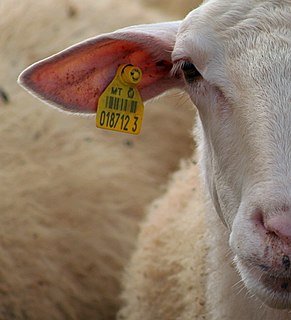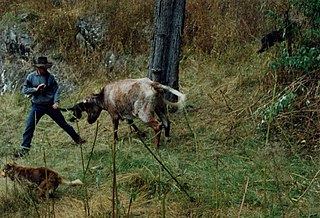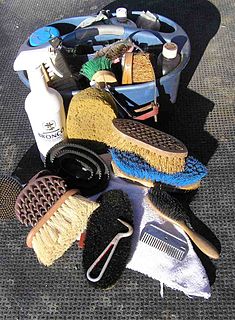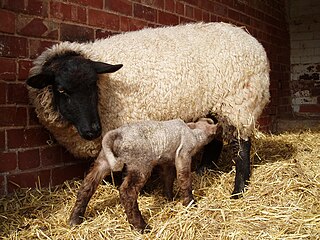
Collies form a distinctive type of herding dogs, including many related landraces and standardized breeds. The type originated in Scotland and Northern England. Collies are medium-sized, fairly lightly-built dogs, with pointed snouts. Many types have a distinctive white color over the shoulders. Collies are very active and agile, and most types of collies have a very strong herding instinct. Collie breeds have spread through many parts of the world, and have diversified into many varieties, sometimes mixed with other dog types. Some collie breeds have remained as working dogs for herding cattle, sheep, and other livestock, while others are kept as pets, show dogs or for dog sports, in which they display great agility, stamina and trainability. While the American Kennel Club has a breed they call "collie", in fact collie dogs are a distinctive type of herding dog inclusive of many related landraces and formal breeds. There are usually major distinctions between show dogs and those bred for herding trials or dog sports: the latter typically display great agility, stamina and trainability, and, more importantly, sagacity.

Docking is the removal of portions of an animal's tail. While docking and bobbing are more commonly used to refer to removal of the tail, the term cropping is used in reference to the ears. Tail docking occurs in one of two ways. The first involves constricting the blood supply to the tail with a rubber ligature for a few days until the tail falls off. The second involves the severance of the tail with surgical scissors or a scalpel. The length to which tails are docked varies by breed, and is often specified in the breed standard.

Sheep farming or sheep husbandry is the raising and breeding of domestic sheep. It is a branch of animal husbandry. Sheep are raised principally for their meat, milk, and fiber (wool). They also yield sheepskin and parchment.
Mulesing is the removal of strips of wool-bearing skin from around the breech (buttocks) of a sheep to prevent the parasitic infection flystrike (myiasis). The wool around the buttocks can retain faeces and urine, which attracts flies. The scar tissue that grows over the wound does not grow wool, so is less likely to attract the flies that cause flystrike. Mulesing is a common practice in Australia for this purpose, particularly on highly wrinkled Merino sheep. Mulesing is considered by some to be a skilled surgical task. Mulesing can only affect flystrike on the area cut out and has no effect on flystrike on any other part of the animal's body.

Crutching refers to the removal of wool from around the tail and between the rear legs of a sheep for hygiene purposes. It can also refer to removing wool from the heads of sheep. It does not refer to the process of mulesing - a controversial procedure that is considered unacceptable in many parts of the world and being phased out in others.

An ear tag is a plastic or metal object used for identification of domestic livestock and other animals. If the ear tag uses Radio Frequency Identification Device (RFID) technology it is referred to as an electronic ear tag. Electronic ear tags conform to international standards ISO 11784 and ISO 11785 working at 134.2 kHz, as well as ISO/IEC 18000-6C operating in the UHF spectrum. There are other non-standard systems such as Destron working at 125 kHz. Although there are many shapes of ear tags, the main types in current use are as follows:
Banding is a medical procedure which uses elastic bands for constriction. Banding may be used to tie off blood vessels in order to stop bleeding, as in the treatment of bleeding esophageal varices. The band restricts blood flow to the ligated tissue, so that it eventually dies and sloughs away from the supporting tissue. This same principle underlies banding as treatment for hemorrhoids.

The Jacob is a British breed of domestic sheep. It combines two characteristics unusual in sheep: it is piebald—dark-coloured with areas of white wool—and it is often polycerate or multi-horned. It most commonly has four horns. The origin of the breed is not known; broken-coloured polycerate sheep were present in England by the middle of the seventeenth century, and were widespread a century later. A breed society was formed in 1969, and a flock book was published from 1972.

A muster (Au/NZ) or a roundup (US) is the process of gathering livestock. Musters usually involve cattle, sheep or horses, but may also include goats, camels, buffalo or other animals. Mustering may be conducted for a variety of reasons including routine livestock health checks and treatments, branding, shearing, lamb marking, sale, feeding and transport or droving to another location. Mustering is a long, difficult and sometimes dangerous job, especially on the vast Australian cattle stations of the Top End, 'The Falls' (gorge) country of the Great Dividing Range and the ranches of the western United States. The group of animals gathered in a muster is referred to as a "mob" in Australia and a "herd" in North America.
The Finnish Landrace, Finn or Finnsheep is a breed of domestic sheep native to Finland. It is one of several Northern European short-tailed sheep breeds, but is notable for its high incidence of multiple births – it is common for a ewe to have three, four, or even five lambs at once.

Docking is the intentional removal of part of an animal's tail or, sometimes, ears. The term cropping is more commonly used in reference to the cropping of ears, while docking more commonly—but not exclusively—refers to the tail. The term tailing is also commonly used. The term arises because the living flesh of the tail, from which the animal's tail hairs grow, commonly is known as the dock.

Horse grooming is hygienic care given to a horse, or a process by which the horse's physical appearance is enhanced for horse shows or other types of competition.

The Shetland is a small, wool-producing breed of sheep originating in the Shetland Isles, Scotland but is now also kept in many other parts of the world. It is part of the Northern European short-tailed sheep group, and it is closely related to the extinct Scottish Dunface. Shetlands are classified as a landrace or "unimproved" breed. This breed is kept for its very fine wool, for meat, and for conservation grazing.

The raising of domestic sheep has occurred in nearly every inhabited part of the globe, and the variations in cultures and languages which have kept sheep has produced a vast lexicon of unique terminology used to describe sheep husbandry.

Elastration is a bloodless method of male castration and docking commonly used for livestock. Elastration is simply banding the body part until it drops off. This method is favored for its simplicity, low cost, and minimal training requirements.

Domestic sheep reproduce sexually much like other mammals, and their reproductive strategy is furthermore very similar to other domestic herd animals. A flock of sheep is generally mated by a single ram, which has either been chosen by a farmer or has established dominance through physical contest with other rams. Most sheep have a breeding season (tupping) in the autumn, though some are able to breed year-round.

Sheep are quadrupedal, ruminant mammals typically kept as livestock. Like most ruminants, sheep are members of the order Artiodactyla, the even-toed ungulates. Although the name sheep applies to many species in the genus Ovis, in everyday usage it almost always refers to Ovis aries. Numbering a little over one billion, domestic sheep are also the most numerous species of sheep. An adult female is referred to as a ewe, an intact male as a ram, occasionally a tup, a castrated male as a wether, and a young sheep as a lamb.
The Animal Health and Welfare (Scotland) Act 2006 is an Act of the Scottish Parliament. It received Royal Assent on 11 July 2006.

Numerous procedures performed on domestic animals are usually more invasive than purely cosmetic alterations, but differ from types of veterinary surgery that are performed exclusively for urgent health reasons. Such procedures have been grouped together under the technical term mutilatory by the Royal College of Veterinary Surgeons in a report describing the reasons for their being conducted and their welfare consequences, and by others.













